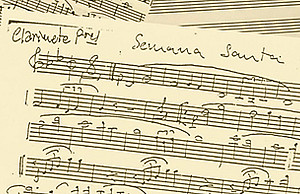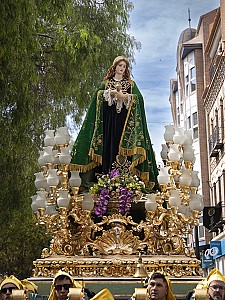| Vox populi |
| La Magdalena |
| Origen y constitución |
| Se constituye en 1941, aunque sus orígenes se remontan al siglo XIX |
| Los primeros Estatutos conservados datan de 1942 |
| Día, Procesión y Paso |
| Lunes Santo en el Vía Crucis-Procesional del Santísimo Cristo de la Sangre |
| Miércoles Santo en la Procesión General con Santa María Magdalena |
| Viernes Santo en la Procesión del Penitente con Santa María Magdalena |
| Domingo de Resurrección en la Procesión del Resucitado con Santa María Magdalena |
La Imagen titular llega a Cieza en 1881; así consta en el libro de encargos de su autor, el imaginero murciano Joaquín Eusebio Baglietto: "Por la construcción de la imagen de María Magdalena de Altura de el natural para vestir dicha Ymagen es para el pueblo de Cieza colocada en la Ermita del Santisimo Cristo entramuros en frente de la Estación mandada acer por D. Pedro Martínez capellan de las Monjas Claras de dicho pueblo ha llebado por ella 1.200 reales entregada el dia 10 de Marzo de 1881".
La Imagen fue encargada por el sacerdote ciezano D. Pedro Marín Martínez, 'Macharro' -como se le conocía popularmente- capellán que fue del Monasterio de la Inmaculada Concepción, 'Las Claras', para ocupar los retablos laterales de la Ermita del Santísimo Cristo del Consuelo, cuyas obras habían acabado en 1879.
Fue su primera Camarera Dña. Visitación Aguado, quien se encargó de costear el trono así como el vestido, manto, pañuelo y turbante de la Imagen; los bordados y hechuras de estos atuendos fueron realizados en 1892 por las señoritas María Solera y Carmen Pérez Marín, aprovechando el traje de boda de Dña. Pascuala Marín, suegra de Dña. Visitación. La peluca, que siempre fue rubia, se hizo con pelo natural de su propia Camarera. A la muerte de esta en 1917 se hizo cargo de la Imagen Dña. Carmen Camacho, a la que sustituyó su sobrina Dña. Pilar Gómez hasta el año 1940, año en el que D. Mariano Camacho se hace cargo del Paso y pasa a regentar la camarería su esposa Dña. Clara García que lo siguió haciendo hasta su muerte en 1993.
El primitivo trono, algo más pequeño que el actual, fue realizado en 1893 por el Maestro Cañamón, tallista ciezano que debido a las pequeñas dimensiones de su taller tuvo que montarlo en plena calle, y fue dorado por 'Perico el pintor'. El que ahora procesiona es una obra tallada en madera y dorada por el escultor malagueño afincado en Cieza Juan Solano García, a quien le fue encargado en 1953 por la Cofradía estrenándose el año siguiente; fue restaurado en el año 2000 por Bonifacio Pérez Ballesteros, a excepción de los brazos de luz que lo fueron en el año 2003 en el taller de Domingo García Chauán en Albatera y de las puntas de vara que fueron talladas en madera y doradas en Sevilla por Antonio Ibáñez Valles en 2006, y completado con un nuevo juego de galas bordadas en oro sobre terciopelo por las propias Hermanas en 1999.
Durante la Semana Santa, trono e Imagen se arreglaban en la cochera de los Aguados, sita en los Ejíos de Marín. Desde allí y junto con el Paso de La Oración del Huerto participaba en la 'Traída de los Santos', esperando en la Esquina de la Villa la llegada de los Pasos que bajaban de la Ermita del Santísimo Cristo del Consuelo, precediendo luego al grupo hasta la Iglesia de Nuestra Señora de la Asunción para participar en las Procesiones General, del Penitente, del Santo Entierro y del Resucitado que también encabezaba; de ahí el dicho tan común en Cieza, 'Anda con Dios y que la Magdalena te guíe'.
Inicialmente el Paso de Santa María Magdalena no contó con Hermandad propia; de hecho, en los primeros decenios del siglo XX, debido al estrechamiento de los lazos que vinculaban a los Pasos que no poseían Cofradía propia con determinados oficios, posiblemente para asegurar su salida en procesión, el Paso de Santa María Magdalena se asignó a los esparteros.
Después del lapsus que supuso la Guerra Civil y hasta el año 1945 la Imagen se guardará en el Convento de San Joaquín y San Pascual para emplazarse después por un largo periodo de tiempo en la Ermita del Santísimo Cristo del Consuelo desde donde participará nuevamente en la popular 'Traída de los Santos' mientras esta tuvo vigencia, habiendo recuperado hace unos cuantos años su tradicional Traslado de la tarde de Miércoles Santo.
Entretanto, en 1941 y siendo Hermano Mayor del Paso D. Mariano Camacho Blaya, se funda la Hermandad, cuya presencia se hará patente, como antaño, en las Procesiones de Miércoles Santo, Viernes Santo y Domingo de Resurrección. Actualmente el Paso mantiene las salidas en la Procesión General de Miércoles Santo, en la del Penitente de la mañana de Viernes Santo -de la que estuvo ausente entre 1994 y 1999, por desfilar su Hermandad con otro Paso en su lugar- y en la del Resucitado de Domingo de Resurrección, habiendo dejado de hacerlo en la del Santo Entierro de la noche de Viernes Santo en 2005, coincidiendo con la adquisición del nuevo trono para el grupo escultórico del Santísimo Cristo Yacente, cuya Mayordomía se encuentra vinculada a la Hermandad de Santa María Magdalena.
Precisamente para sustituir a la Imagen de Nuestra Señora del Dolor, que forma parte del grupo escultórico del Santísimo Cristo Yacente, por su precario estado de conservación, esta adquirió en 2005 al escultor sevillano Luis Álvarez Duarte una Imagen de vestir de la Virgen de su propiedad y la bautizó con la advocación de Nuestra Señora del Mayor Dolor; para dicha Imagen confeccionaron las Hermanas de la Cofradía ese mismo año un vestido y un manto brocados, y se adquirió un año después una aureola de plata realizada en la orfebrería sevillana de los Hermanos Delgado López.
Las recaudaciones de las diversas actividades que organiza la Cofradía posibilitan que en 1942 se diseñen las nuevas túnicas de tela azul -en sustitución de la originales de color encarnado- con el tradicional gorro de 'moco' oro para los anderos, y de pana azul con capa y capuz de raso dorado para los nazarenos, y se adquieran los primeros instrumentos de la Banda de tambores y cornetas, encargándose además el proyecto para un nuevo Paso, El Descendimiento de Cristo, que finalmente no llegará a realizarse.
En 1970 y para tomar el relevo de D. Mariano Camacho es nombrado Presidente D. Manuel Martínez, que acomete la labor de realizar un nuevo manto para la Imagen así como el estandarte de la Hermandad, bordados ambos por la cartagenera Concha Escámez en 1971, a los que se sumará en el año 2001 un nuevo traje bordado en terciopelo por las propias mujeres de la Hermandad.
Después de unos titubeantes años, en 1977 se hace cargo de la Cofradía un grupo de amigos encabezado por D. José Gómez Rubio que, partiendo de la nada y viéndose obligado el primer año de su mandato a procesionar con trajes de paisano y sin Banda de música, logra sacar a la Cofradía de la crisis en la que se halla sumida. Un año después, los anderos vuelven a desfilar con sus características túnicas y resurge con nuevos bríos la Banda de cornetas y tambores, dirigida por D. Manuel Piñera Marín, el 'Pistolas'. A D. José Gómez, elegido Presidente de la Junta de Hermandades Pasionaria de Cieza en 1988, le suceden en el cargo D. Francisco Martínez Camacho, bajo cuyo mandato se sustituyen los antiguos báculos del Tercio de Nazarenos en forma de cáliz por otros nuevos con idéntico motivo realizados por el orfebre ciezano Diego Penalva, D. José Sánchez Ramos y D. Manuel Ruiz Marín, trágicamente fallecido al poco tiempo de haberse iniciado su mandato.
Asume entonces la presidencia D. Antonio Ruiz Lucas, bajo cuyo gobierno la Hermandad adquiere en 1994 su propia Casa y su segundo Paso, La Exaltación de la Cruz, que consta de siete Imágenes realizadas en resina de poliéster, tres de las cuales serán modificadas un año después, por el escultor ciezano Antonio Martínez Villa, quien es también el autor del trono, tallado en madera decorada en azul y oro, y en cuyos vértices figuran las Imágenes de los cuatro Evangelistas; el Paso desfila entre 1994 y 1999 en la Procesión del Penitente en la mañana de Viernes Santo sustituyendo a su titular, siendo reemplazado nuevamente por este en el año 2000. Durante su mandato se realizará también la que por ahora es la última restauración de la Imagen de Santa María Magdalena, que fue llevada a cabo en 1996 por Javier Bernal Casanova, y que a su vez había sido la primera intervención de ese tipo que había sufrido la Imagen desde que en la pasada década de los 30 el imaginero ciezano Manuel Carrillo García le retocara el gesto de la boca para adecuarlo al gusto de los ciezanos.
Nuevamente bajo la presidencia de D. José Gómez Rubio, y a fin de recuperar la advocación del 'Cristo de la Sangre', cuyo rastro se pierde en el siglo XIX y que podría haber sido la advocación del titular de la Cofradía de la Sangre de Cristo, desaparecida a mediados del s. XVIII, así como el Vía Crucis con que desde tiempo inmemorial había contado la Semana Santa de Cieza, la Hermandad adquiere el Paso del Santísimo Cristo de la Sangre, de porte andaluz, compuesto por una Imagen de Cristo Crucificado al que acompaña a sus pies otra de un Ángel sosteniendo un cáliz, obras ambas talladas en madera y policromadas por el imaginero sevillano Luis Álvarez Duarte, y por un trono en madera barnizada, obra de del tronista sevillano Antonio Ibáñez Valles, con cartelas alusivas a la Pasión cinceladas en bajorrelieve de plata por Orfebrería Maestrante, también de Sevilla.
Con este nuevo Paso la Hermandad de Santa María Magdalena, cuyos cofrades incorporaron para la ocasión el gorro de 'verdugo' a su vestuario y un nuevo medallón-escapulario al año siguiente, desfila a partir del año 2001 en Vía Crucis-Procesional la noche de Lunes Santo, en un cortejo que en el año 2004 queda completado con una cruz guía, realizada en madera en los talleres sevillanos de Antonio Ibáñez Valles, ciriales, adquiridos en los Talleres de arte Moreno de Granada, e incensario, realizado en Sevilla en Losseises.
Fotografías de Manuel Carpio y Enrique Centeno.
© Junta de Hermandades Pasionarias de Cieza

















